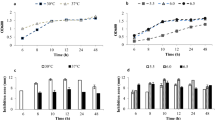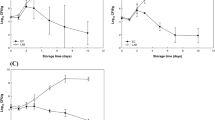Abstract
Lactococcus lactis subsp. lactis WK11 was introduced as a starter in kimchi fermentation to investigate the role of starter cultures in extending the shelf life of kimchi. Kimchi, with an initial inoculum size of 107 CFU/g as well as control kimchi without the starter culture, were prepared and fermented for 56 days at 8°C. The addition of L. lactis prolonged the optimal fermentation period (pH 4.2, acidity 0.6–0.8%) up to more than 2 times. The starter culture, L. lactis WK11, persisted throughout the kimchi fermentation, as confirmed by regular monitoring of the L. lactis population by PCR-DGGE. Taken together, our results suggest that L. lactis starter culture may be useful for extending the shelf-life of kimchi without adverse effects of kimchi with a longer shelf life.
Similar content being viewed by others
References
Chang JY, Chang HC. Improvements in the quality and shelf life of kimchi by fermentation with induced bacteriocin-producing strain, Leuconostoc citreum GJ7 as a starter. J. Food Sci. 75: M103-M110 (2010)
Han GJ, Choi HS, Lee SM, Lee EJ, Park SE, Park KY. Addition of starters in pasteurized brined baechu cabbage increased kimchi quality and health functionality. J. Korean Soc. Food Sci. Nutr. 40: 110–115, (2011)
Han JS, Kang J. Retardation of kimchi fermentation by addition of glucono-δ-lacton. J. Korean Soc. Food Sci. Nutr. 33: 553–559, (2004)
Kim DH, Hahn YS. Effect of addition of ethanol and organic acids on the quality of mul-kimchi. J. East Asian Soc. Dietary Life 13: 305–312, (2003)
Park JG, Kim JH, Park JN, Kim YD, Kim WG, Lee JW, Hwang HJ, Byun MW. The effect of irradiation temperature on the quality improvement of kimchi, Korean fermented vegetables, for its shelf stability. Radiat. Phys. Chem. 77: 497–502, (2008)
Pyun YR, Shin SK, Kim JB, Cho EK. Studies on the heat penetration and pasteurization conditions of retort pouch kimchi. Korean J. Food Sci. Technol. 15: 414–420, (1983)
Shon KH, Lee HJ. Effect of high pressure treatment on the quality and storage of kimchi. Int. J. Food Sci. Tech. 33: 359–365, (1998)
Yang JS, Ji YS, Park HJ, Lee JE, Park SY, Yeo SY, Shin HK, Holzapfel WH. Selection of functional lactic acid bacteria as starter cultures for the fermentation of Korean leek (Allium tuberosum Rottler ex Spengel.). Int. J. Food Microbiol. 191: 164–171, (2014)
Choi HJ, Kim YJ, Lee NR, Park HW, Jang JY, Park SH, Kang MR, Kim HJ, Lee JH, Lee JH, Pyun YR, Kim TW. Selection of lactic acid bacteria with antibacterial activity for extension of kimchi shelf-life. J. Korean Soc. Food Sci. Nutr. 43: 328–332, (2014)
Sadiq S, Imran M, Hassan MN, Iqbal M, Zafar Y, Hafeez FY. Potential of bacteriocinogenic Lactococcus lactis subsp. lactis inhabiting low pH vegetables to produce nisin variants. LWT-Food Sci. Technol. 59: 204–210, (2014)
Park H, Khang Y. Simple and rapid extraction of a bacteriocin produced by Streptococcus parauberis Z49 from fermented cultures. Korean J. Microbiol. 46: 291–295, (2010)
Taylor TM, Davidson PM, Zhong Q. Extraction of nisin from a 2.5% commercial nisin product using methanol and ethanol solutions. J. Food Protect. 70: 1272–1276, (2007)
Kim J, Bang J, Beuchat LR, Kim H, Ryu JH. Controlled fermentation of kimchi using naturally occurring antimicrobial agents. Food Microbiol. 32: 20–31, (2012)
Lee KE, Lee YH. Effect of Lactobacillus plantarum as a starter on the food quality and microbiota of kimchi. Food Sci. Biotechnol. 19: 641–646, (2010)
Chang JY, Lee HJ, Chang HC. Identification of the agent from Lactobacillus plantarum KFRI464 that enhance bacteriocin production by Leuconostoc citreum GJ7. J. Appl. Microbiol. 103: 2504–2515, (2007)
Chang JY, Chang HC. Growth Inhibition of foodborne pathogens by kimchi prepared with bacteriocin-producing starter culture. J. Food Sci. 76: M72-M78 (2011)
Park JM, Shin JH, Bak DJ, Chang UJ, Suh HJ, Moon KW, Yang CY, Park H, Kim JM. Effect of Leuconostoc mesenteroides strain as a starter culture isolated from the kimchi. Food Sci. Biotechnol. 22: 1729–1733, (2013)
So MH, Shin MY, Kim YB. Effects of psychrotrophic lactic acid bacterial starter on kimchi fermentation. Korean J. Food Sci. Technol. 28: 806–813, (1996)
Yang EJ, Chang JY, Lee HJ, Kim JH, Chung DK, Lee JH, Chang HC. Characterization of the antagonistic activity against Lactobacillus plantarum and induction of bacteriocin production. Korean J. Food Sci. Technol. 34: 311–318, (2002)
Choi HJ, Kim YJ, Lee NR, Park HW, Jang JY, Park SH, Kang MR, Kim HJ, Lee JH, Lee JH, Pyun YR, Kim TW. Selection of lactic acid bacteria with antibacterial activity for extension of kimchi shelf-life. J. Korean Soc. Food Sci. Nutr. 43: 328–332, (2014)
Author information
Authors and Affiliations
Corresponding author
Rights and permissions
About this article
Cite this article
Jang, JY., Lee, M.E., Lee, HW. et al. Extending the shelf life of kimchi with Lactococcus lactis strain as a starter culture. Food Sci Biotechnol 24, 1049–1053 (2015). https://doi.org/10.1007/s10068-015-0134-8
Received:
Revised:
Accepted:
Published:
Issue Date:
DOI: https://doi.org/10.1007/s10068-015-0134-8




